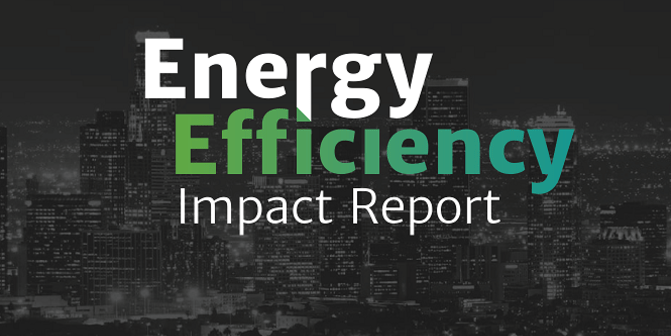Introducing the Energy Efficiency Impact Report: Finally, a Guide to the Numbers
Let's Save Energy
Alliance to Save Energy's Blog

There’s an expression that “people who don’t value energy efficiency keep forgetting the numbers.”
The expression can often crack a smile among energy efficiency advocates, as it references a familiar, if maddening paradox that energy efficiency has extensive data demonstrating its effectiveness, yet it is often overlooked and underestimated.
But it also raises a fair question: what are the numbers?
For the U.S., there is no shortage of technical reports and studies that discuss the benefits of energy efficiency, ranging from the outputs of the Alliance’s initiatives, the veritable library of reports from our partners at the American Council for an Energy-Efficient Economy (ACEEE), or the Business Council for Sustainable Energy (BCSE) and BloombergNEF’s Sustainable Energy in America Factbook (not to mention the extensive reports and studies from federal agencies such as the Department of Energy, Environmental Protection Agency, and the national laboratories – I could go on).
However, these resources often hone in on one aspect of energy efficiency, whether it’s transportation efficiency or the time-varying value of electric energy efficiency, the decarbonization potential of energy efficiency programs or the market impacts of the ENERGY STAR program. To date, there hasn’t existed a single resource that summarizes the full picture in a sufficiently concise and accessible format to tell energy efficiency’s story for a wider audience. Until now.
This week, the Alliance, ACEEE, and BCSE jointly released the Energy Efficiency Impact Report, a digital and graphically-heavy report telling the story of energy efficiency’s impacts on the U.S. economy, environment, and society, across a variety of sectors (utilities, buildings, industry, transportation). The report relies on 54 indicators to show the breadth, depth, and diversity of energy efficiency progress in recent years.
The Energy Efficiency Impact Report was unveiled at an event in Washington, D.C., on Tuesday morning feautring report authors and contributors.
Through this analysis, the report identifies six main cross-cutting themes:
- Energy efficiency fuels the economy. Energy efficiency doesn’t imply economic sacrifices. Energy productivity doubled since 1980; the U.S. supports 2.3 million energy efficiency jobs; and energy-efficient technologies, such as refrigerators, have seen greater efficiency accompanied by increased capacity and falling prices for consumers.
- Energy efficiency improves lives and the planet. Energy efficiency not only saves energy, but provides a host of co-benefits. Energy efficiency investments since 1980 have prevented a 60% increase in carbon emissions, avoided over $500 million in spending on public health, and lead to more productive, profitable, and healthy commercial working environments.
- Energy efficiency policies work. Investments in energy efficiency programs deliver results. Utility energy efficiency programs scaled up from 2006 to the present, seeing a tripling of electricity savings; in natural gas, increased investments since 2011 led to a doubling of savings. Additionally, states that implement policies to incentivize energy efficiency see positive effects.
- Energy efficiency is a high-priority resource. Energy efficiency can be considered as a resource similar to other generation resources (coal, natural gas, oil, nuclear, hydro, renewables) – to satisfy demand, an electric utility can choose to save a kWh, or generate a new one. When considered in this frame, energy efficiency is not only a plentiful resource, but it is often the most affordable. In many cases utilities view energy efficiency as a reliable resource necessary to achieve state-level decarbonization goals and to keep the lights on.
- Energy efficiency has untapped potential. While energy efficiency has driven enormous positive impacts, we haven’t exhausted its potential. This is true for the known technologies that have been available for decades, as well as for new technologies and innovations that are beginning to emerge (such as smart meters, advanced controls, automation, and artificial intelligence). Estimates show that by relying on existing technology and ramping up our policy ambition, aggressive energy efficiency deployment could cut our carbon emissions in half.
- Energy efficiency investment is critical. While the numbers are not comprehensive on the total levels of energy efficiency investment, one estimate from the International Energy Agency notes that energy efficiency investment in the United States fell by 18% from 2016 to 2018, and investment has also slowed in PACE financing and Green Bank investments. While investments continue to grow in other areas, this is a warning sign that our commitment to energy efficiency is wavering.
Energy efficiency has always required enormous commitment on the part of many parties: governments, industry stakeholders, society. The last 40 years have seen energy efficiency stabilize energy consumption despite our increasingly energy-rich lives. But in a time of climate change and international competition, we don’t have 40 years to engineer the next level of progress.
STAY EMPOWERED
Help the Alliance advocate for policies to use energy more efficiently – supporting job creation, reduced emissions, and lower costs. Contact your member of Congress.
Energy efficiency is smart, nonpartisan, and practical. So are we. Our strength comes from an unparalleled group of Alliance Associates working collaboratively under the Alliance umbrella to pave the way for energy efficiency gains.
The power of efficiency is in your hands. Supporting the Alliance means supporting a vision for using energy more productively to achieve economic growth, a cleaner environment, and greater energy security, affordability, and reliability.




